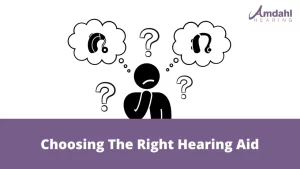Any time we’re asked about the “best” hearing aids, we try to discuss choosing the “right” hearing aids. While this may seem like a subtle difference, that difference is really important. You see, there is no “best” hearing aid for everyone. There are, however, “right” or “correct” hearing aids for everyone. Determining that best choice can involve some work.
What to Consider When Choosing Hearing Aids
At Amdahl Hearing, our providers look at many different factors when choosing the correct hearing aids. Those factors are:
- What do the hearing aids look like?
- What technology level, features, and accessories are necessary?
- What is the out-of-pocket cost to the patient?
Once we know these answers, we can make the best possible decision on hearing aids.
Let’s break these three down.
What do the hearing aids look like?
This may seem like an odd place to start, but after thirty years of fitting hearing aids, we’ve learned that if people won’t wear hearing aids because they are embarrassed by how they look, the hearing aids don’t work. So, picking a style that is acceptable to the patient is extremely important. Amdahl Hearing providers spend a significant amount of time discussing the effects that different styles of hearing aids will have on hearing, performance, and patient adaptation. With a good idea of the rehab involved, both the patient and provider have appropriate expectations for the fitting process.
What technology level, features, and accessories are necessary?
This is where providers can really start to geek out. This is the part where we get to think and talk about all of the nerdy technology stuff that we love so much. Before you completely glaze over, here are the highlights:
Channels and Bands
As we know, hearing loss is almost always different at each frequency (pitch), so it’s important to have the ability to provide different amounts of power at each pitch. Just like a graphics equalizer on those cool stereos from the 80s, hearing aids have bands to help us adjust how the hearing aids process sound. Furthermore, the different channels allow us to control the volume range in different pitch ranges as well. In general, the more channels and bands, the better we can help patients hear—but only if the hearing loss requires it. The more simple the hearing loss, the less technology we require.
Noise Reduction Technology
Noise reduction technology is not what most people think. We are not removing “background noise” from the hearing aids. We like to define background noise as “anything or anyone that I don’t want to hear.” Clearly, the hearing aids have no way of knowing what we want to hear, so they don’t remove unwanted background noise.
Here is what they can do. Hearing aids use sophisticated processes to analyze the sound entering each channel. If that channel is dominated by a signal that is deemed to be noise by the processor, amplification is either reduced, eliminated, or decreased relative to the rest of the signal. In contrast, channels deemed to contain speech are appropriately amplified. The result of these processes is a signal that is more pleasant, which tends to make noisy environments more comfortable and less taxing on the patient overall, creating a much better listening experience.
Connectivity (Bluetooth)
As the world continues to become more “connected,” our ability to use technology such as computers, tablets, and other mobile devices is becoming more and more necessary. In the not-so-distant past, people with hearing aids were basically excluded from the party. Many devices can now be connected via Bluetooth, allowing for wireless streaming of calls, videos, social media, and many other applications. When making a decision on technology, connectivity should always be considered.
Accessories
This category is where truly understanding a patient’s lifestyle is so important. Whether it’s a TV streamer, a table microphone, or a remote control (to mention a few), accessories can be the difference between hearing or not.
Out-of-Pocket Cost
Yep, this is where the rubber meets the road. The unfortunate reality is that many times insurance does not cover hearing aids. If patients do have coverage, there is still some out-of-pocket expense the majority of the time. At Amdahl Hearing, our job is simple. Recommend the best possible solution for each patient. With that recommendation comes an associated cost. While not always the most comfortable conversation, it’s critical that we have it. We are here to help. If our recommendation and your checkbook don’t see eye to eye, please just let us know. There are plenty of ways to make it work—we just need to know so we can help.
If you have questions about your hearing or hearing aids, please give us a call at 320.252.0094, look up online at amdahlhearing.com or email me directly at info@amdahlhearing.com
